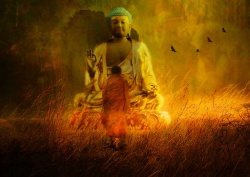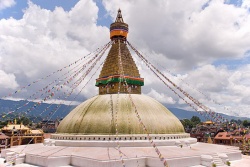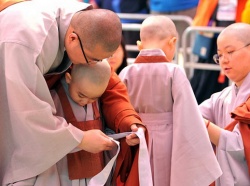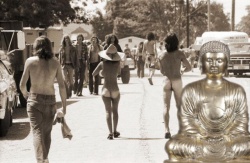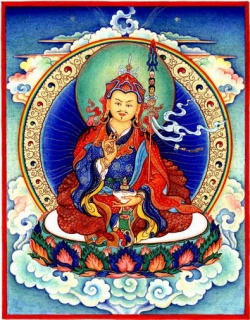Buddhist Advice on Death and Dying
The 14th Dalai Lama
We’re all going to face death, so we shouldn’t ignore it. Being realistic about our mortality enables us to live a full, meaningful life. Instead of dying with fear, we can die happily because we’ll have made the most of our lives.
Leading a Meaningful Life
Over the years, our bodies have changed. Generally speaking, even spirituality or meditation cannot stop that from happening. We are impermanent, always changing, changing from moment to moment; and that is part of nature. Time is always moving; no force can stop that. So the real question is whether we are utilizing time properly or not. Do we use time to create more problems for others, which also ultimately makes us ourselves feel unhappy deep inside? I think that’s a wrong way to utilize time.
A better way is to try to shape our minds every day with a proper motivation and then carry on the rest of the day with that sort of motivation. And that means, if possible, serving others; and if not, at least refraining from harming others. In that respect, there’s no difference among professions. Whatever your profession, you can have a positive motivation. If our time is used in that way over days, weeks, months, years – decades, not just for five years – then our lives become meaningful. At the very least, we’re making some sort of contribution toward our own individual happy mental state. Sooner or later our end will come, and that day we’ll feel no regrets; we’ll know we used our time constructively.
Having a Realistic Attitude about Death
Our present lives, however, are not forever. But to think: “Death is the enemy” is totally wrong. Death is part of our lives. Of course, from the Buddhist viewpoint, this body is in some sense an enemy. In order to develop genuine desire for moksha – liberation – then we do need that kind of attitude: that this very birth, this body, its very nature is suffering and so we want to cease that. But this attitude can create a lot of problems. If you consider death is the enemy, then this body is also the enemy, and life as a whole is the enemy. That’s going a little bit too far.
Of course, death means no longer existing, at least for this body. We’ll have to part from all the things that we developed some close connection to within this lifetime. Animals don’t like death, so naturally it’s the same with human beings. But we are part of nature, and so death is part of our lives. Logically, life has a beginning and an end – there’s birth and death. So it’s not unusual. But I think our unrealistic approaches and views about death cause us extra worry and anxiety.
So as Buddhist practitioners, it is very useful to remind ourselves daily about death and impermanence. There are two levels of impermanence: a grosser level [that all produced phenomena come to an end] and a subtle level [that all phenomena affected by causes and conditions change from moment to moment]. Actually the subtle level of impermanence is the real teaching of Buddhism; but generally the grosser level of impermanence is also an important part of practice because it reduces some of our destructive emotions that are based on feeling that we’ll remain forever.
Look at these great kings or rajahs – in the West also – with their big castles and forts. These emperors considered themselves immortal. But now when we look at these structures, it’s rather silly. Look at the Great Wall of China. It created such immense suffering for the subjects who built it. But these works were carried out with the feeling: “My power and empire will remain forever” and “My emperor will remain forever.” Like the Berlin Wall – some East German communist leader said it would last for a thousand years. All these feelings come from their grasping at themselves and their party or their beliefs and from thinking they will remain forever.
Now it is true that we need positive desire as part of our motivation – without desire there’s no movement. But desire combined with ignorance is dangerous. For example, there’s the feeling of permanence that often creates the kind of view that “I will remain forever.” That’s unrealistic. That’s ignorance. And when you combine that with desire – wanting something more, something more, something more – it creates even more trouble and problems. But, desire with wisdom is very positive, and so we need that.
We also see reminders of impermanence in tantric practice, with skulls and these types of things, and in some mandalas we visualize cemeteries, the charnel grounds. All these are symbols to remind us of impermanence. One day my car passed through a cemetery, so it was fresh in my mind when I mentioned it later in a public talk: “I just was passing through the cemetery. That’s our final destination. We have to go there.” Jesus Christ on the cross showed his followers that finally death comes. And Buddha did similarly. Allah, I don’t know – Allah has no form – but of course Muhammad demonstrated it.
So therefore we need to be realistic that death will come sooner or later. If you develop some kind of attitude right from the beginning that death will come; then when death actually does come, you’ll be much less anxious. So for a Buddhist practitioner, it’s very important to remind ourselves of this on a daily basis.
What to Do at the Time of Death
When our final day comes, we need to accept it and not see it as something strange. There’s no other way. At that time, someone who has faith in a theistic religion should think, “This very life was created by God, so the end is also according to God’s plan. Although I do not like death, God created it, and so there must be some meaning to it.” Those people who truly believe in a creator god should think along those lines.
Those who follow the Indian traditions and believe in rebirth should think about their future life and make some effort to create the right causes for a good future life, instead of worry, worry, worry. For example, at the time of dying you could dedicate all your virtues so your next life will be a good life. And then, no matter what our beliefs, at the time of dying, the mental state must be calm. Anger, too much fear – these are not good.
If possible, Buddhist practitioners should use their time now to look ahead to their next lives. Bodhichitta practices and certain tantric practices are good for this. According to the tantric teachings, at the time of death there’s the eight-stage dissolution of the elements – the grosser levels of the elements of the body dissolve, and then the more subtle levels also dissolve. Tantric practitioners need to include this in their daily meditation. Every day, I meditate on death – in different mandala practices – at least five times, so still I’m alive! Already this morning I’ve gone through three deaths.
So these are the methods to create a guarantee for a good next life, like that. And for non-believers, as I mentioned earlier, it’s important to be realistic about the fact of impermanence.
How to Help Those Who Are Dying
With those people who are actually dying, it’s good if the surrounding people have some knowledge [of how to help]. As I mentioned earlier, with those dying people who believe in a creator god, you can remind them of God. A single-pointed faith in God has at least some benefit, from a Buddhist point of view as well. With those people who have no belief, no religion, then as I mentioned earlier, be realistic, and it’s important to try to keep their minds calm.
Having crying relatives around the dying person might be detrimental to them keeping a calm mind – too much attachment. And also because of too much attachment toward their relatives, there’s the possibility of developing anger and seeing death as an enemy. So it’s important to try to keep their mental state calm. That’s important.
On many occasions I’ve been requested to go to Buddhist hospices. Like in Australia there’s a nunnery where the nuns are totally dedicated to taking care of dying people and those with serious illnesses. This is a very good way of putting our daily practice of compassion into action. That’s very important.
Summary
Death isn’t something strange. It occurs every single day, all over the world. Understanding that we will definitely die encourages us to lead a meaningful life. When we see that it could come at any time, we’re much less likely to fight and argue over petty things. Instead, we become motivated to make the most of life by benefiting others as much as possible.
Transcribed by Sean Jones and Michael Richards, edited by Luke Roberts and Alexander Berzin, with clarifications indicated between square brackets.
